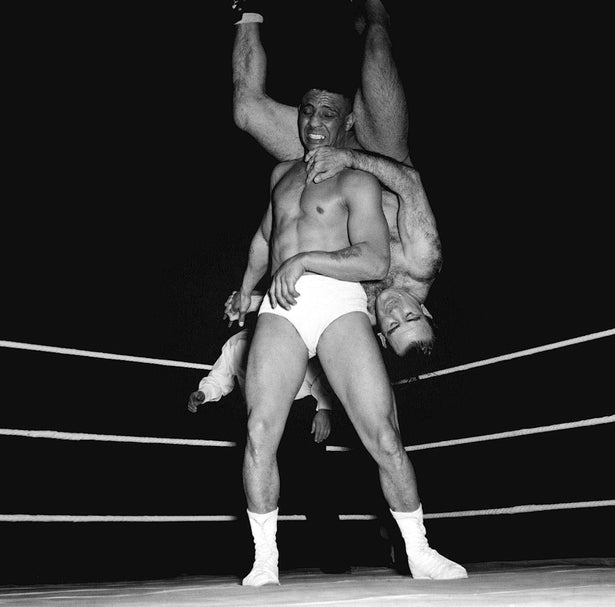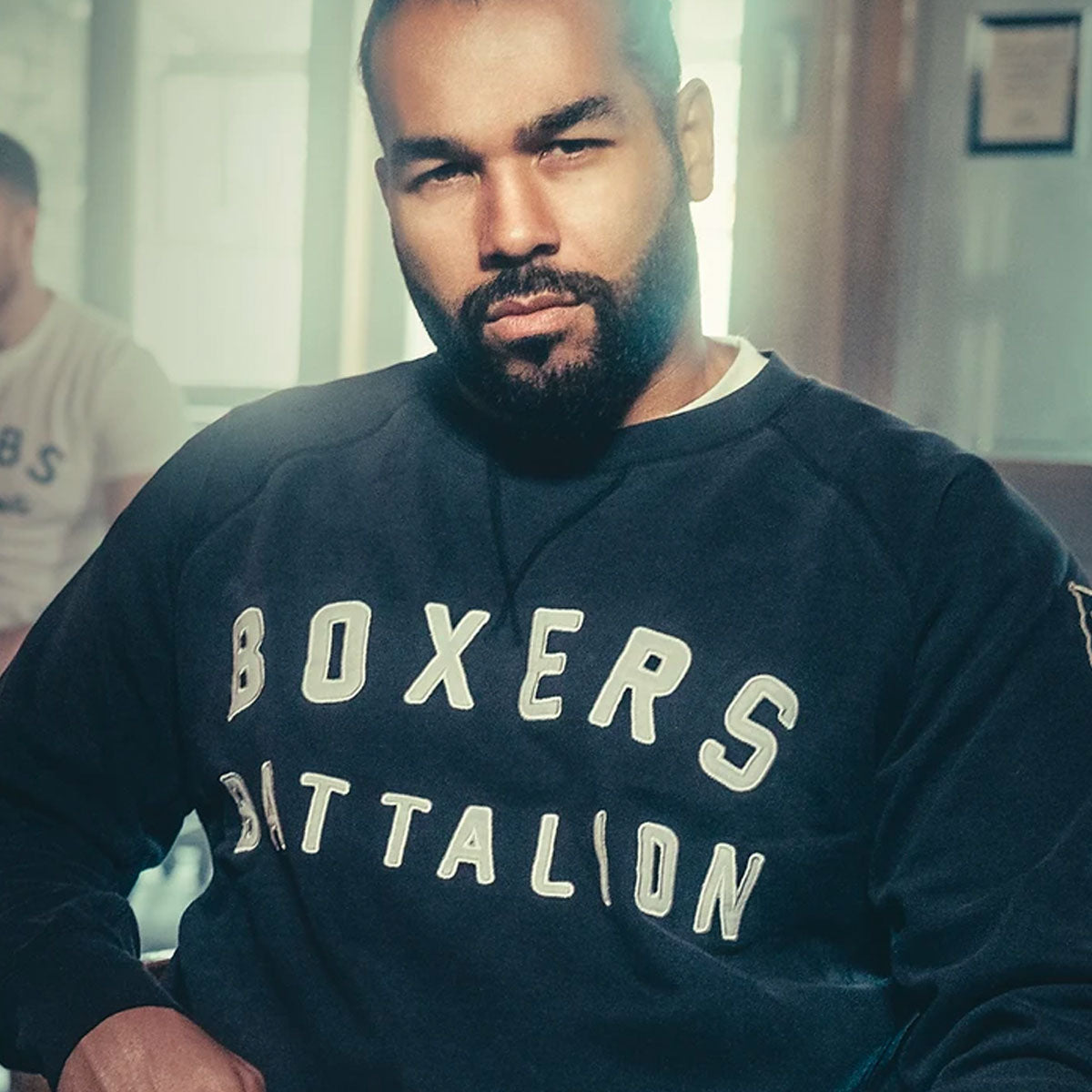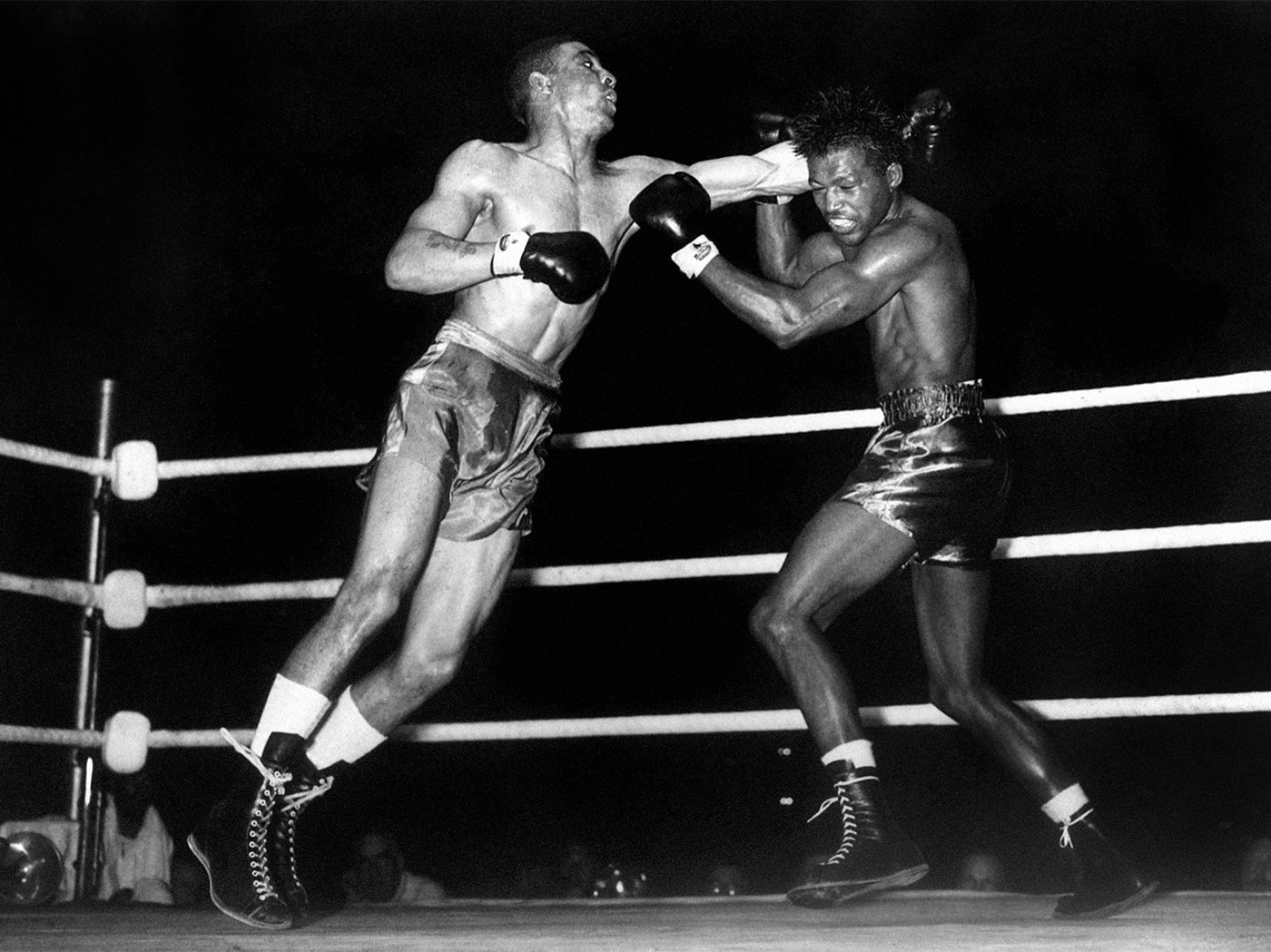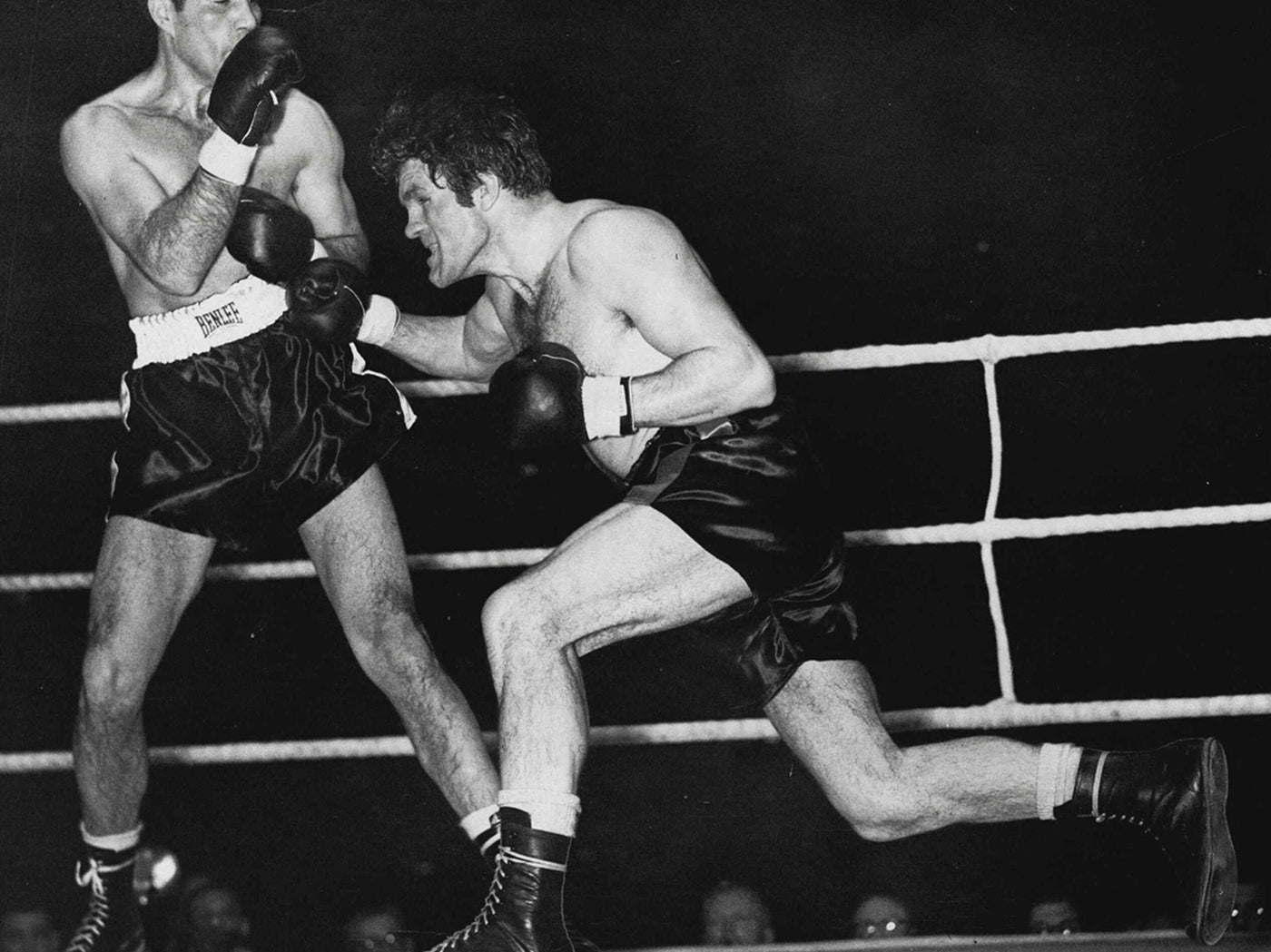When you mention Randy Turpin in conversation, most will quickly refer to his victory against pound for pound legend, Sugar Ray Robinson. However, there’s a great more to the man than that career defining moment.
On 7 June 1928 Randolph Adolphus Turpin entered this world in a basement flat at 6 Willes Road in Leamington Spa. His presence can still be felt there to this very day as a blue plaque now marks the property. His mother, Beatrice Whitehouse was tough as they came. A combination of her father, Tommy Whitehouse, being a bare knuckle fighter and losing her husband shortly after Randolph was born. Lionel Fitzherbert Turpin came over from British Guyana to fight in the First World War, which included active service at the Battle of The Somme. He never fully recovered from injuries from a gas attack and died when young Randolph was only three months old.
Beatrice now had the task of raising two girls and three sons. Jackie, Randolph and Dick (born Lionel Junior) all turned professional, but it was Dick who picked up the first accolade for the Turpin name when he became the first black boxer allowed to fight for a British title and then win it in 1948. He also went on to pick up the Commonwealth title and campaigned at European and world levels against the likes of Marcel Cerdan.
Young Randolph had his own spars with life before stepping in the ring, with his first opponents being double pneumonia and bronchitis. Another incident left him with partial hearing loss for life after being caught underwater in some river weeds. Thankfully it never affected his balance which would prove to be essential in his future trade.
At the age of 12, Warwickshire’s future world champion officially laced up the gloves and went on to clock up 100 amateur fights, losing only five. He became ABA Class A National Junior champion three years running from 1943 to 1945 for Leamington Boys Club. Then in 1945 he won the under 69KG category in the senior ABA’s and the year after repeated the feat in the 75KG category, but this time representing the Royal Navy. That’s five years of ABA honours, including two successive senior accolades. Impressive stuff. It’s also worth noting that when he won senior ABA honours in 1945, he made history by being the youngest person to do so at 17 years old. Turpin served in the Navy from 1945 as an assistant cook and would remain in the armed forces until 1948.

A precursor of Turpin’s volatile life happened in 1945, when the teenager allegedly swallowed either liniment or disinfect, in what seemed attempted suicide after an argument with his girlfriend Mary Stack. After investigation it was deemed an accident – albeit it, the warning bell had already signalled for the future. Despite unsteady foundations from the start the pair married in 1947. From the opening stanza, the teenage bride and groom had a number of issues, including Turpin’s infidelity, through to his controlling and intimidating character, which led to a number of domestic abuse allegations against him. Despite having one son, Randolph Jr, the pair would eventually divorce in 1953. Sadly, father and son never exchanged a word their entire lives.
Back to the boxing. A few months after gaining his second successive senior ABA crown, Turpin turned professional on 17 September 1946 at the Harringay Arena in North London, fighting on the undercard of Bruce Woodcock versus Gus Lesnevich. Eager to leave a lasting impression with the onlookers, Turpin stopped Gordon Griffiths in the first round. Within his first 12 months as pro, Turpin racked up 15 wins with only four of his opponents reaching the final bell.
Turpin only competed six times in 1948, incurring two losses, one of which was a fifth round knockout against Jean Stock. However, in his next three years, he more than made up for it. After 12 straight wins, on 17 October 1950, at the Harringay Arena, Turpin exacted revenge on the first man to put a loss on his record in 1948, Albert Finch. The fifth round stoppage over the Croydon resident tasted good for a number of reasons. He’d avenged his own loss, but also settled a family affair as brother Dick had been beaten twice by Finch earlier that year. Most importantly, he’d relieved Finch of his British middleweight title.

Turpin defeats Albert Finch for the British middleweight title, October 1950
Four months later, now boasting a record of 35-2-1, Turpin took on Dutchman Luc Van Dam for the vacant European middleweight crown. Shortly after the opening bell Randy cracked Van Dam with a right hook to the jaw and it was goodnight Rotterdam in 48 seconds. Winning the European title propelled him up the world rankings and one almighty step closer to a world title shot.
After winning his next four fights by stoppage, including a defence of his European crown to another Dutchman, Jan De Bruin, Turpin was handed the opportunity of a lifetime. On 10 June 1951 at Earls Court Arena, Kensington, the Warwickshire Warrior was taking on the reigning world middleweight champion and arguably the best pound for pound fighter of all time, Sugar Ray Robinson.
Just in case you were wondering what version of Sugar Ray was stepping through the ropes that night, the answer is a very dangerous one. Robinson had only lost once in 132 contests and that was at the hands of Jake LaMotta back in 1943. He avenged the LaMotta loss two weeks later, then defeated him a further five times over the coming years, including a bout in February 1951 for the world middleweight title. Washed up he wasn’t.
Turpin wins the world middleweight title
Robinson turned up with his entourage in a pink Cadillac at Earls Court Arena, which included his barber, whilst Turpin and his team took the London Underground. That night in Kensington, Turpin, the natural middleweight weighed in at a pound and half shy of the 160lbs limit, whereas Robinson weighed a fraction over 154lbs, making him a modern day super welterweight. From the opening bell, Turpin was neither fazed by the occasion or the opponent and stuck to his gameplan of box-fighting Robinson with a relentless work rate. After opening a cut over Robinson’s eye in the seventh round, Randy kept applying the pressure in front of the 18,000 strong crowd and did a great job of making Sugar Ray miss with his jab on countless occasions, a feat very few were able to achieve.
After 15 hard fought rounds and despite looking a little lethargic in the final stanza, referee Eugene Henderson raised the hand of ‘the new’ middleweight champion of the world. Twenty three years old and you’ve just beaten Sugar Ray Robinson for the world middleweight title. Let that set in for a moment. Many believed Turpin peaked that night.
After winning the title, Turpin was greeted by 10,000 people lining the streets of Leamington. As the second Brit to have won the world middleweight crown, the first being Bob Fitzsimmons 60 years prior in 1891, Turpin received the hero’s welcome he deserved. Unfortunately for Leamington’s favourite fighting son, his reign lasted a touch over two months, 64 days to be precise, due to a 90 day rematch clause. The rematch was to be held at the Polo Grounds, New York on 12 September 1951.
After landing on U.S. soil, Turpin headed to The Catskills to train. Unfortunately, he made a stop in Manhattan enroute and took in all the glitz, glamour and ladies a newly crowned champion could absorb.
Robinson started the rematch strong in front of 61,000 fans, looking physically more imposing as he weighed closer to the full middleweight limit this time round, however, it certainly wasn’t a one sided contest. As the pair locked horns in the tenth round, Turpin landed a haymaker of a right hand which sliced open a cut over Robinson’s left eye, followed by further blows, which opened a healthy stream of blood down his face. Unfortunately for Turpin, wily Robinson locked Randy into a clinch and a split second after the referee separated them, he landed his own perfectly placed right hand to Turpin’s temple, sending him to the canvas. Robinson, aware that the fight might be stopped on account of the severity of his cut followed up with a barrage of punches until the referee halted the contest.
Turpin earned around £11,000 for the first Robinson clash whereas his promoter Jack Solomon made almost four times that. For the rematch, Randy grossed £70k, (around £750k nowadays), while the promoters, Solomon and a shady bunch believed to have had mafia links, grossed almost twice that figure. Despite investing in a new dwelling on his return, money slipped through Turpin’s fingers like water.
After clocking up two stoppage wins, on 10 June 1952 at White City Stadium, Turpin took on The Battersea Blacksmith, Don Cockell for the vacant British and Commonwealth light heavyweight titles. Despite being outweighed by 12lbs, Turpin not only won the contest but knocked Cockell down three times before eventually stopping him in eleventh round. He was now a two weight British champion. Cockell would eventually move up to heavyweight and in a gutsy move took on The Brockton Blockbuster, Rocky Marciano. Click here to read more. https://www.britishvintageboxing.com/post/the-battersea-blacksmith-don-cockell

Campaigning back at middleweight, Turpin won his next five fights then travelled Stateside once again to challenge for the world middleweight crown. The difference this time when he challenged for the crown as the underdog, is that he lacked training discipline. At the weigh-in, Bobo Olsen, sporting a big dragon tattoo on his right arm, decades before fighters were getting inked by the herd load looked in great shape. Turpin on the other hand didn’t.
On 21 October 1953 at Madison Square Garden, Turpin took on Hawaiian born Olson. In brief, Turpin got beaten up for the full 15 rounds, which included getting knocked down twice. At one point he was actually pleading with his brother Dick who was in the corner, ‘Get me out of here.’ 
Turpin vs Olson 1953
Shortly after the fight, Turpin was arrested by the New York police department for an assault charge connected to Adele Daniels. The case was withdrawn for whatever reasons (and apparently with no evidence of assault), but she proceeded to then try and sue him for an amount larger than the Olson purse for damages. Rumour has it he had falsely promised her marriage. He paid her £1,250 in the end. In addition to the happenings with his first wife and now these fresh accusations, Turpin’s reputation was getting beaten to a pulp. He quickly jumped back on the Queen Mary vessel and headed home.
The same year, Turpin married Gwyneth Price and then moved to Llandudno, in her native surroundings of Wales. The couple would eventually have four daughters. As a family they went on to open ‘Randy’s Bar,’ and also invested into The Great Ormes Head Hotel with business associate Leslie Salts. Both were failed business. A non-affiliated bar still stands there to this very day. They also bought, ‘Gwen’s Transport café,’ at a time when Turpin was bankrupt, which would become famous for all the wrong reasons a few years down the line.
Despite losing to Olson, Turpin was still European middleweight champion and on 2 May 1954 he travelled to Tiberio Mitri’s backyard at the Stadio Torino, Rome to defend his strap. Shortly after the opening bell Turpin was clipped with a left hook a touch below his right ear, which scrambled his senses. As he tried to get to his feet he stumbled helplessly and the referee intervened at one minute and five seconds of the opening stanza. Mitri was the new champion.
Many believed Turpin should have retired after this fight, having suffered two back-to-back beatings. He was still young, but the type of fights he had engaged in and his warrior come forward style had meant that he’d taken a great deal of punishment. However, against the advice of concerned parties, including his wife, friends and family, Turpin continued to fight.
Down on his luck, but not out, on 26 April 1955 at the Harringay Arena, Turpin knocked out Alex Buxton in the second round to become British and Commonwealth light heavyweight champion for the second time. Five months later he beat Polly Smith and then suffered a fourth round knockout against Gordon Wallace on 18 October 1955. He announced a short lived retirement and was back in the ring six months later.
On 26 November 1956 he fought Buxton again for the newly vacated British and Commonwealth light heavyweight titles. By knocking Buxton out in the fifth round, he not only won the titles again but was added to an elite group of fighters to have won the Lonsdale belt outright.
After winning his next seven fights, six by knockout, Turpin was knocked out in two rounds by Trinidad and Tobago native, Yolande Pompey. It was a fight he should never have been offered and an another unnecessary beating he suffered.
After nearly five years, desperate for cash, Turpin came back for two unlicensed fights against debutants, beating them both by knockout. Thankfully he hung up the gloves for good after his final fight against Charles Seguna in Monaco on 22 August 1964, walking away with a very respectable 66 wins, eight losses and one draw. He won the British and Commonwealth titles in two weight divisions, won the Lonsdale Belt outright at light heavyweight and became European and world middleweight champion. You can’t knock that resume.
In a career spanning 22 years, Turpin cleared around £135,000, which in 2021 money would be around £2.5million. Between divorce expenses, bad investments, extravagant living and an untold number of loans and handouts to hangers on, he had nothing to show for all the concussive blows he took in the prize ring. At the age of 30 he was working down a scrapyard to make ends meet. The fall from grace from winning the title against Sugar Ray Robinson was a long harsh drop off a cliff edge. 
Funnily enough though, Turpin seemed at his happiest in the scrapyard environment, but the spotlight and pound notes called him back to the ring once again, but this time in the guise of a wrestler. Travelling the length and breadth of the country for a few notes whilst still living a lavish lifestyle, Turpin had discounted his toughest opponent – the tax man. Like so many greats in years gone, such as Joe Louis, Turpin was one visit away from being financially TKO’d, with no means to recoup his monetary insolvency.
Existing depression set in to a darker and deeper level, leaving Turpin with a sense of helplessness, abandonment and pure fear of not being able to help his family as his fourth daughter was born. On 17 May 1964 he was found dead above Gwen’s Transport café. He left a letter declaring depression over his financial status and also that he’d had three attempts on his life from debtors to recoup their cash from him. Using a .22 calibre handgun he allegedly shot his youngest daughter Carmen, only 17 months old at the time and then turned the gun on himself and shot himself, inflicting wounds to the heart and head. Turpin died but incredibly, his daughter made a full recovery. He was 37 years old.
The letter hand been hand typed as opposed to written, which left many believing he hadn’t taken his own life and that it was actually murder. The fact that he’d also managed to shoot himself in the heart and head also remained a mystery.
His funeral, compared to his homecoming parade after the Robinson victory was somewhat underattended. The financial leaches who would have benefitted from his heyday were nowhere to be seen. However, 50 years after becoming champion of the world, Randolph Adolphus Turpin was inducted into the International Boxing Hall of Fame in 2001 and a statue of the Leamington Licker was also erected in Market Place, Warwick. He had become a fallen hero and this was a resurrection of sorts within the boxing world for a man who had more than earned his penance in the ring.
Paul Zanon, has had 11 books published, with almost all of them reaching the No1 Bestselling spot in their respective categories on Amazon. He has co-hosted boxing shows on Talk Sport, been a pundit on London Live, Boxnation and has contributed to a number of boxing publications, including, Boxing Monthly, The Ring, Daily Sport, Boxing News, Boxing Social, amongst other publications.






